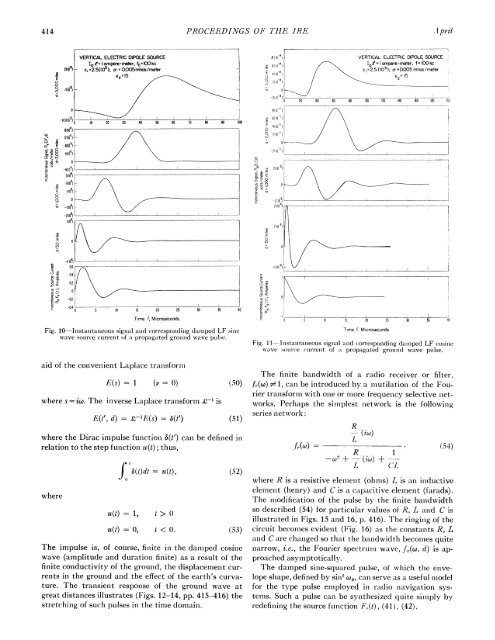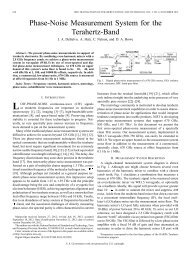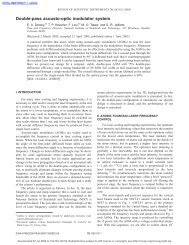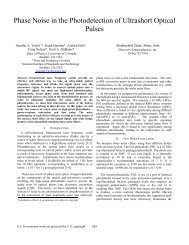Propagation Low-Frequency
Propagation Low-Frequency
Propagation Low-Frequency
Create successful ePaper yourself
Turn your PDF publications into a flip-book with our unique Google optimized e-Paper software.
414 PROCEEDINGS OF THE IRE<br />
.1 pril<br />
Vg 1505<br />
12001<br />
E 8° 0'°<br />
o 4(101<br />
2101<br />
e<br />
0<br />
0e<br />
-49<br />
-2(169)<br />
U)4)<br />
'0 10 20 30 40 50 60 70 80 90 100<br />
|1<br />
0. ___ _<br />
-20A<br />
04<br />
z 02 -<br />
-04 .0 5 15 20 25 30 35 40<br />
Time. t Microseconds<br />
Fig. 10-Instanltaneous signlal atod correspondliiog damped LF sinle<br />
wave soulrce currenlt of a1 propalgated groulnd ssave pullse.<br />
aid of the convenient Laplace tranisform<br />
E(s) =1 (v= 0)<br />
where s =iw. The inverse Laplace tranisform £-C is<br />
E(t', d) = £''E(s) =<br />
(t)<br />
where the Dirac impulse funlctioln 6(t') can be definied in<br />
relation to the step funictioin u(t); thus,<br />
where<br />
rt b()dt =(t),<br />
,,j<br />
u(t)=1, I>0<br />
(52)<br />
u(t) =O t < 0. (53)<br />
The impulse is, of course, finiite in the danmped cosine<br />
wave (amplitude and durationi finlite) as a result of the<br />
finite conductivity of the ground, the displacement currents<br />
in the ground and the effect of the earth's curvature.<br />
The transient response of the ground wave at<br />
great distances illustrates (Figs. 12-14, pp. 415-416) the<br />
stretching of such pulses in the time domain.<br />
'E<br />
uT E<br />
V)<br />
3C<br />
.1<br />
-a<br />
lT<br />
-0<br />
-3E<br />
2 0)<br />
c<br />
el<br />
I0<br />
400-1<br />
2(10-I)<br />
O -2, If0 0 20<br />
_ _ 40<br />
VERTICAL ELECTRIC DIPOLE SOURCE<br />
1of= ampere-meter; f=I-Okc<br />
c, =2.5(io5); o0=0.005 mhos/meter<br />
If2= 5<br />
60 80 100 120 140 160 180 20',<br />
T<br />
IXtt ^1> 1f1^ IAX $1vX 1nt 4tir~~~~~~~~~~~~~~~~~~~~~~~~~~~~~~~<br />
~~~ \-<br />
\~~~~~~~~~~~~~~~~~~~~~~~~~~~~~~~~~~~~~<br />
.S<br />
i 4 i . I~~~~~~~~~~~~~~~~~~~~~~~~~~<br />
"I -ti<br />
- O 5 iO 15 20 25 30 35 40<br />
Time, t Microseconds<br />
Fig. 11- Instanitanieous sigInal anid correspoindinig daniped LF cosinie<br />
xs ave souirce (current of a1 propagated gronioid wave ptulse.<br />
The finiite bandwidth of a radio receiver or filter,<br />
(50°) fr(°) #;£ 1, cani be introduced by a mutilation of the Fourier<br />
transform with onie or more frequency selective nietworks.<br />
Perhaps the simplest nietwork is the followinig<br />
f ,1\series network:<br />
(-51)<br />
fr(co)<br />
R<br />
I<br />
(ico)<br />
- R I<br />
-co2 +- (iw) + -<br />
L C'L<br />
(54)<br />
where R is a resistive elemnenit (ohms) L is an iniductive<br />
element (henry) and C is a capacitive element (farads).<br />
The n1odificationi of the pulse by the finite bandwidth<br />
so described (54) for particular values of R, L anid C is<br />
illustrated in Figs. 15 anid 16, p. 416). The ringinig of the<br />
circuit becomes evident (Fig. 16) as the constants R, L<br />
and C are changed so that the bandwidth becomes quite<br />
narrow, i.e., the Fourier spectrumii wave, fJ0(w, d) is approached<br />
asymptotically.<br />
The damped sine-squared pulse, of which the enivelope<br />
shape, defined by sinil w, can serve as a useful nmodel<br />
for the type pulse employed in radio navigation systems.<br />
Such a pulse can be syiothesized quite simiply by<br />
redefining the source funiction F,(t), (41), (42),<br />
__





